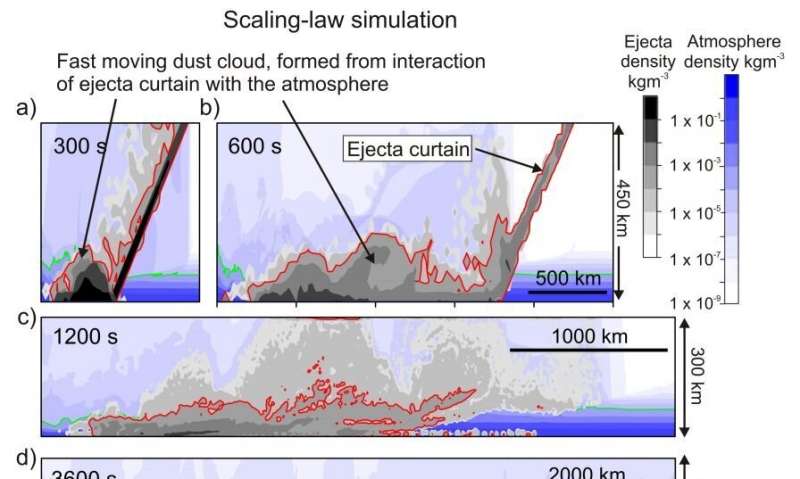March 26, 2020 report
Simulation: Dust could have spread evenly over Earth after Chicxulub asteroid strike

Bob Yirka
news contributor

Two researchers, one with the Planetary Science Institute, the other Imperial College, have created a simulation that they believe shows how dust could have spread so evenly over the whole Earth after the Chicxulub asteroid strike. In their paper published in the journal Geographical Research Letters, Natalia Artemieva and Joanna Morgan describe the arduous process by which they studied what happened after the asteroid strike that killed off the dinosaurs, and what they learned.
When a volcano erupts, volcanic dust travels through the air and eventually drops to the ground. Places closer to the volcano wind up with deeper carpets of ash and dust because the dust is dispersed as it travels away from the volcano through the air. The same should be true for dust and debris kicked up when an asteroid strikes the ground—that's what happens in most cases. But when the Chicxulub asteroid hit the ground near what is now the Yucatan peninsula, the dust it kicked up settled in an even coat over the entire Earth. How this might have happened has been a mystery until now.
To find the answer, Artemieva and Morgan embarked on a research mission that wound up spanning an entire decade. They studied asteroid strikes, large volcanic eruptions and even explosions, looking for a similar incident. But it was not until they analyzed the comet Shoemaker-Levy 9 striking Jupiter that they found what they had hypothesized: an impact could result in dust spreading horizontally over a very widespread area. And better yet, the whole scenario had happened in modern times, allowing it to be recorded—and allowing the researchers to watch the proceedings unfold.
They found that the reason the dust was able to spread was because it warmed the atmosphere once it arrived there, which created a conveyance system. With that discovery in hand, the researchers went back to their lab and created a simulation showing the dust from the Chicxulub strike warming the atmosphere. And just as happened on Jupiter, the simulation showed the dust being carried horizontally—in their case, all over the Earth—before it finally fell back to the ground in even amounts.
Written for you by our author —this article is the result of careful human work. We rely on readers like you to keep independent science journalism alive. If this reporting matters to you, please consider a (especially monthly). You'll get an ad-free account as a thank-you.
More information: Natalia Artemieva et al. Global K‐Pg Layer Deposited From a Dust Cloud, Geophysical Research Letters (2020).
Journal information: Geophysical Research Letters
© 2020 Science X Network





















